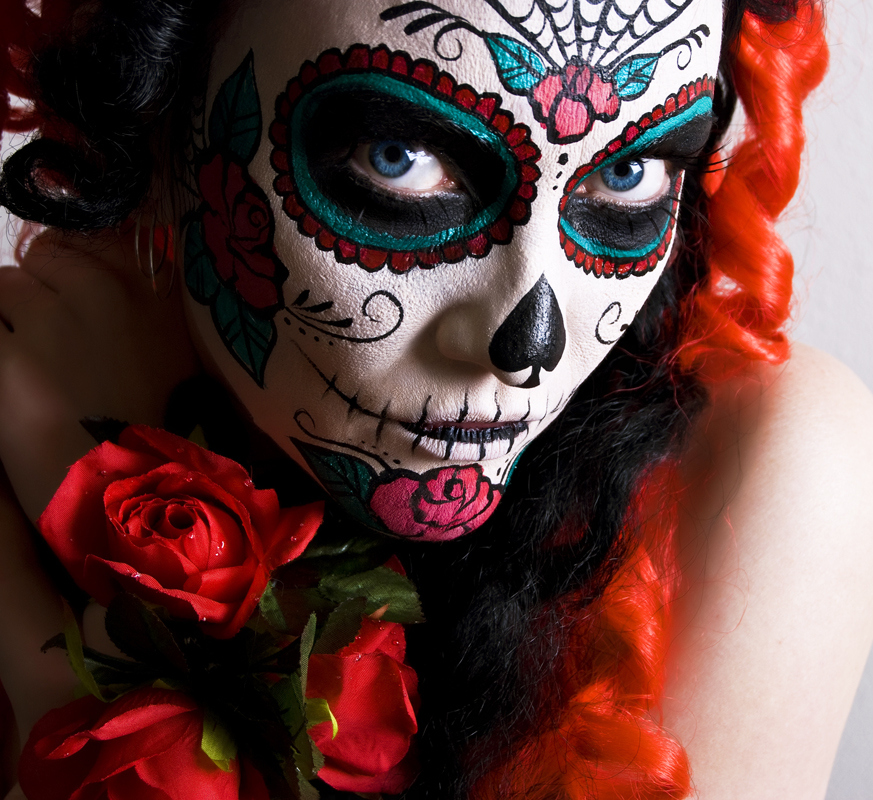
Santa Muerte is a sacred figure and feminine skeletal folk saint venerated primarily in Mexico and the United States. As a figure made holy by popular belief, the saint of death developed through syncretism between Mesoamerican indigenous and Spanish Catholic beliefs and practices. Santa Muerte, the name in Spanish, literally translates to "Saint Death" or "Holy Death".
Since the pre-Columbian era Mexican culture has maintained a certain reverence towards death, which can be seen in the widespread commemoration of the syncretic Day of the Dead. Elements of that celebration include the use of skeletons to remind people of their mortality. The worship is condemned by the Catholic Church in Mexico as invalid, but it is firmly entrenched among Mexico’s lower working classes and various elements of society deemed as "outcasts".
Santa Muerte generally appears as a female skeletal figure, clad in a long robe and holding one or more objects, usually a scythe and a globe. Her robe can be of any color, as more specific images of the figure vary widely from devotee to devotee and according to the rite being performed or the petition being made.
As the worship of Santa Muerte was clandestine until the 20th century, most prayers and other rites have been traditionally performed privately in the home.
The number of believers in Santa Muerte has grown over the past ten to twenty years, to several million followers in Mexico, the United States, and parts of Central America. Santa Muerte has similar male counterparts in the Americas, such as the skeletal folk saints San La Muerte of Argentina and Rey (King) Pascual of Guatemala.
Santa Muerte is referred to by a number of monikers such as Señora de las Sombras ("Lady of the Shadows"), Señora Blanca ("White Lady"), Señora Negra ("Black Lady"), Niña Santa ("Holy Girl"), and La Flaca ("The Skinny Lady"). Some devotees call her Santa Sebastiana (St. Sebastienne) or Doña Bella Sebastiana ("Our Beautiful Lady Sebastienne"), since St. Sebastian was an early Christian martyr and is, among other things, patron saint of having a holy death.
Images of Santa Muerte range from mass-produced articles sold in shops throughout Mexico and the U.S. to handcrafted effigies. Sizes vary immensely from small images held in one hand to those requiring a pickup truck to transport them. Some people even have the image tattooed on their bodies.

Her appearance varies, but she typically dons either long robes or dresses, covered from head to toe with only her face and hands showing. The robe or dress covers her skeletal figure like flesh covers the bones of the living. Both are said eventually to fall away.
The most common image is of Saint Death in a robe, with a scythe in the right hand and the globe in the left. However, there are many variations on the color of the cloak, and on what Santa Muerte holds in her hands. Interpretations of the color of her robe and accoutrements vary as well.

The scythe can symbolize the cutting of negative energies or influences. Also, as a harvesting tool, it can symbolize hope and prosperity. Moreover, her scythe, which reflects her origins as the Grim Reapress ("la Parca" of medieval Spain), can represent the moment of death, when it is said to cut a silver thread. The scythe has a long handle, indicating that it can reach anywhere.
The globe represents Death's dominion over the earth, and can be seen as a kind of a tomb to which we all return. Having the world in her hand also symbolizes vast power.
Other objects that can appear with an image of Santa Muerte include scales, an hourglass, an owl, and an oil lamp. The scales allude to equity, justice, and impartiality, as well as divine will. An hourglass indicates the time of life on earth. It also represents the belief that death is not the end, but rather the beginning of something new, as the hourglass can be turned to start over. The hourglass denotes Santa Muerte's relationship with time as well as with the worlds above and below. It also symbolizes patience. An owl symbolizes her ability to navigate the darkness and her wisdom. The owl is also said to act as a messenger. A lamp symbolizes intelligence and spirit, to light the way through the darkness of ignorance and doubt.




























3 comments:
Fiгѕt οff I want to saу gгeat blog!
I had а quiсk quеѕtion which I'd like to ask if you don't mіnd.
I ωas intereѕted tο know how
you centeг уourself аnd сlear youг head before ωrіtіng.
I've had a tough time clearing my mind in getting my thoughts out. I truly do take pleasure in writing but it just seems like the first 10 to 15 minutes are generally wasted simply just trying to figure out how to begin. Any suggestions or hints? Kudos!
Feel free to visit my weblog: Lloyd Irvin
My brother recommended I might like this web site. He was totally right.
This post actually made my day. You can not imagine simply
how much time I had spent for this information!
Thanks!
Review my homepage - summer internship
Hey! I know this is kinda off topic but I was
wondering which blog platform are you using for this website?
I'm getting sick and tired of Wordpress because I've had problems with hackers and I'm looking at options for another platform. I would be fantastic if you could point me in the direction of a good platform.
my web site - facebook password cracker
Post a Comment